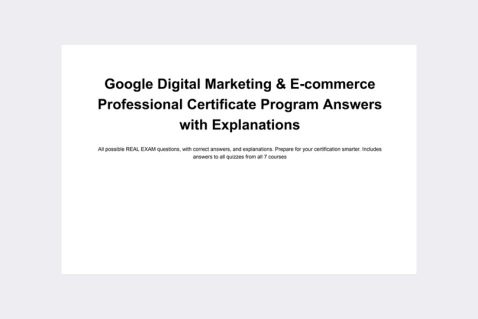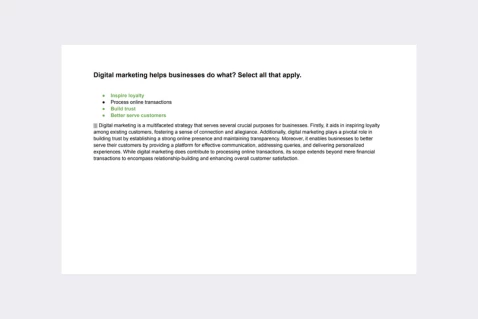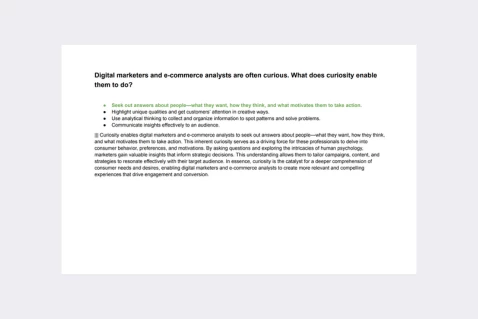As a digital marketer, you update the product page checkout button color after a successful A/B test. This strategy falls under which marketing funnel stage?
Loyalty
Consideration
Conversion
Awareness
Certification program: 👉 Google Digital Marketing & E-commerce Professional Certificate (Coursera)
Explanation: Updating the product page checkout button color after a successful A/B test falls under the Conversion stage of the marketing funnel. In the conversion stage, the primary focus is on turning potential customers into actual buyers. Optimizing elements like the checkout button color is a strategic move to enhance the user experience and streamline the path to purchase, thereby increasing the likelihood of conversions. Unlike awareness, consideration, or loyalty stages, where the emphasis is on different aspects of the customer journey, conversion specifically targets actions that lead to completing a transaction and securing a sale.
Passing exams is not a workout. Multiple attempts won’t make you stronger.



- All possible certificate program questions
- Real certification exam questions
- Detailed answer explanations.
- Over 1700 questions, 7 courses, 30 quizzes
- Free lifetime updates.
Optimizing User Experience: The Role of A/B Testing in the Marketing Funnel
In the fast-paced world of digital marketing, ensuring a seamless and engaging user experience is paramount for driving conversions and achieving business objectives. One powerful technique for optimizing user experience is A/B testing, which involves comparing two or more versions of a webpage or element to determine which performs better in terms of user engagement and conversion rates. But where does A/B testing fit into the marketing funnel, and how can digital marketers leverage it to their advantage? Let’s explore.
Understanding the Marketing Funnel
The marketing funnel, often depicted as a journey that potential customers go through before making a purchase, consists of several stages:
- Awareness: Customers become aware of your brand, product, or service.
- Interest: Customers express interest in your offerings and seek more information.
- Consideration: Customers evaluate your offerings and compare them to alternatives.
- Conversion: Customers make a purchase or complete a desired action.
- Retention: Customers become repeat buyers and advocate for your brand.
The Role of A/B Testing
A/B testing primarily aligns with the conversion stage of the marketing funnel. At this stage, potential customers have expressed interest in your offerings and are considering making a purchase. By conducting A/B tests on elements such as webpage layout, design, copy, and calls-to-action, digital marketers can identify and implement changes that optimize conversion rates and drive more users towards completing desired actions, such as making a purchase.
Practical Insights for A/B Testing
To leverage A/B testing effectively in your digital marketing strategy, consider the following practical insights:
-
Identify Key Variables: Determine which elements of your webpage or user interface are most critical for driving conversions. Focus on variables such as headline copy, button color, call-to-action text, and layout design that are likely to have a significant impact on user behavior.
-
Create Hypotheses: Formulate hypotheses about how changes to these variables may impact user engagement and conversion rates. Develop clear and testable hypotheses based on insights from user research, industry best practices, and your own experience as a digital marketer.
-
Design Experiments: Set up A/B tests using a reliable testing platform or tool. Create variations of the webpage or element being tested, with each version containing a single change to the variable of interest. Randomly assign users to each variation to ensure unbiased results.
-
Measure and Analyze Results: Monitor key performance metrics such as click-through rates, conversion rates, and revenue generated from each variation. Analyze the results of the A/B test to determine which version performed better in terms of achieving your desired objectives.
-
Iterate and Optimize: Use the insights gained from A/B testing to inform future iterations and optimizations of your digital marketing strategy. Implement the winning variation as the new default and continue to test and refine other elements to further improve user experience and conversion rates.
Enhancing User Experience with A/B Testing
In conclusion, A/B testing is a valuable tool for optimizing user experience and driving conversions at the conversion stage of the marketing funnel. By systematically testing and iterating on key variables, digital marketers can identify the most effective strategies for engaging users and guiding them towards desired actions. Whether it’s updating the checkout button color on a product page or refining other elements of your website or marketing campaigns, A/B testing offers a data-driven approach to optimizing user experience and achieving business objectives.
Remember, in the competitive landscape of digital marketing, continuous experimentation and optimization are key to staying ahead of the curve. So, embrace the power of A/B testing as a strategic tool in your marketing toolkit and unlock its full potential to drive conversions and business growth.
Discover our best-value guides
- Special Bundle Offer Google_Ads_Roll
- Special Bundle Offer HubSpot_Exams_Roll
- Special Offer Unchained_Guru_Roll
- Special Bundle Offer Amazon_Roll
- Special Bundle Offer Google_Analytics_Roll
- Special Bundle Offer Google_SkillShop_Roll
- Special Bundle Offer Marketing_Platforms_Roll
- Special Bundle Offer Microsoft_Advertising_Roll
- Special Bundle Offer YouTube_Roll
- Special Bundle Offer Google_Android_Roll
- Ultimate PMP certification preperation guide
- Google Cloud Professional Architect Certification Exam Answers - Ultimate Guide
- Special Bundle Offer SEMrush_Roll